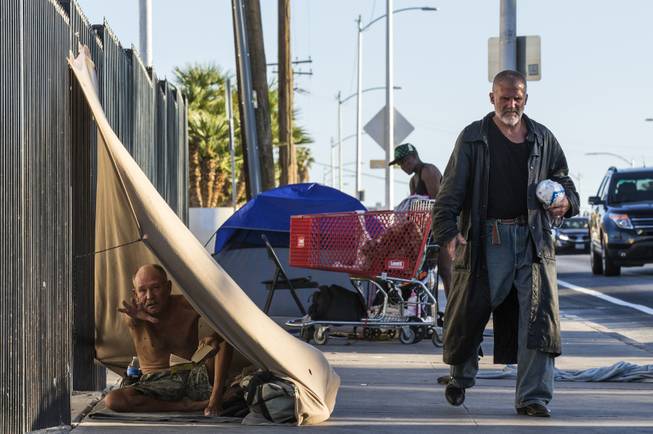
Homeless people are shown on a Las Vegas sidewalk.
Saturday, June 22, 2019 | 2 a.m.
Clark County has spent almost $8 million over the last six months through its strategic plan to end homelessness in Southern Nevada, using money from marijuana business license fees to aid 6,000 homeless residents countywide.
Commissioners have allocated $12 million from the fees for housing programs for homeless families, youth and those with health care needs. Chairwoman Marilyn Kirkpatrick said the county has “been able to do so much,” noting they have “already changed lives.”
But officials say there is still work to be done — and not just with the homeless population. The lack of affordable housing for low-income residents is also alarming and can lead to homelessness.
Social Service Director Michael Pawlak said staff is working toward addressing gaps in the system once homeless families or individuals are placed in housing.
“Even though we connect them to resources, it’s not easy to move them out of programs,” Pawlak said. “If we could give them a little bit of assistance, we may be able to transition them off our program.”
Lack of communication or cooperation between county and municipal resources also creates additional barriers, according to officials.
Officer Keith Hanoff, who is part of the Metro Police Homeless Outreach Team, spends early-morning shifts trying to connect homeless to the resources they need so he can “get them off the streets.” He said last month that he sometimes gets pushback when he tries to connect a homeless person in the county to a social service within one of the surrounding municipalities.
“In the past they haven’t worked or communicated with each other,” he said. “This creates a silo effect.”
There are also groups of homeless who feel they are falling through the cracks and not getting the services they need.
Ty Jones has been a resident of Clark County for six years. At Tuesday’s commission meeting, he said his demographic — minority single males — are overlooked. He also doesn’t have any kids, a severe mental health or substance abuse issue.
“A lot of the programs in the county, although they try to say and proclaim they are there to provide services for everyone, they really are not,” Jones said.
The county is also trying to address the lack of affordable housing for low-income residents.
The National Low Income Housing Coalition lists Nevada as having the most significant affordable housing crisis with the fewest affordable and available rental homes in the country.
This reflects a national crisis, as only 37% of homes are available to low-income renters nationally, according to the coalition.
Low-income is defined as those making between 30% and 50% of the median income for the metropolitan area, the coalition said. And a house is considered cost-burdened if more than 30% of the household income is spent on housing costs, which includes rent and utilities.
Pawlak said the county has initiatives in place to address the crisis, including low-income housing tax credits, private activity bonds and property tax abatement programs.
“We use almost all of these tools in every single development that we build,” he said, in order to make housing units affordable.
Clark County has 1,209 “affordable” units under construction or development, Pawlak said.
Unfortunately, Pawlak said, only 70 of those units cater to extremely low-income individuals, or those at or below the poverty line. According to the U.S. Census, 14% of Clark County citizens are at the poverty level.
“Let’s get some folks at the table and figure this out,” Commissioner Lawrence Weekly said. “We want to live here. We don’t want to get booted out of our community because we’re going to have pro football and all of this stuff here. We love Clark County and we want to live here.”
